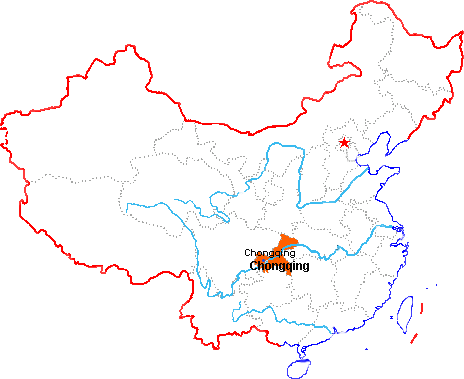China Travel Info/Cities and Attractions/Chongqing |
Chongqing |
 | ||||||
The city of Chongqing can be best described as southwest China 's commercial capital. Since 1997, the city has become the fourth municipality, independent from Sichuan Province , to be under the direct control of the central government. The major port of the upper Yangzi River and gateway to the famous ˇ°Three Gorges , ˇ± Chongqing now includes most of the former eastern Sichuan P rovince , with a population of 30 million. It is a major center of iron and steel production, motorcycle manufacturing and shipbuilding, as well as chemical and pharmaceutical production. The religious cliff sculptures of Dazu and Baodingshan and the Three Gorges scenic region of the Yangzi River are all nearby, making Chongqing an important center for tourism despite the scarcity of notable sights within the city proper. Chongqing lies at the confluence of the Yangzi and Jialingjiang Rivers, centered on a hilly peninsula encircled by the rivers, in what was formerly the eastern part of Sichuan Province . Also known as the Mountain City , Chongqing is 1,025 km (640 miles ) northwest of Hong Kong, and 1,800 km (1,120 miles ) southwest of Beijing . It is one of the four ˇ°furnace citiesˇ± of China , with blazingly hot and humid summers and cold, foggy winters. Chongqing traces its ancient history all the way back to the 13th century BC, when it was the capital of the Ba kingdom, with a distinctive local culture contemporary with the Shang. It was given its present name, which means ˇ°Double Celebration,ˇ± by the Southern Song Emperor Guangzong in 1189, to commemorate his accessions to princely and then imperial rank. At the end of the Song period, from 1242 to 1278, Song forces held off Mongol invaders in the longest continuous military campaign ever on Chinese soil, lasting some 36 years at nearby Hechuan, 60 km to the north of the city. Chongqing was opened as a treaty port to British and Japanese traders in 1890. Chongqing gained political importance following the Japanese invasions of the late 1930' s. After Nanjing fell in 1937, Chongqing became the wartime capital of the Kuomintang regime from 1938 on, and a focus for refugees and bombing raids that destroyed most of the city's historical fabric. After the Japanese surrender in 1945 and the breakdown of U.S. sponsored negotiations held in Chongqing between the Kuomintang leader Chiang Kai-shek and the Communist leader Mao Zedong, Chongqing remained a Kuomintang stronghold until it fell to the People's Liberation Army in 1949. Since then Chongqing has grown dramatically in population and economic importance, becoming the major industrial center of southwestern China . | ||||||
| Attractions | ||||||
|